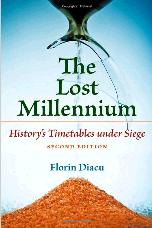
Title: The Lost Millennium: History's Timetables Under Siege
Author: Florin Diacu
Publisher: John Hopkins 2005, 2011 (2nd edition)
Genre: Nonfiction - History
Pages: 237
Rating: 3/5 stars
Reading Challenges: Mixing it Up -- History; Dewey -- 900s
How I Got It: Library Loan
We measure history—its defining moments, landmark documents, and great figures—by dates. The French Revolution began in 1789, the Magna Carta was originally issued in 1215, and Julius Caesar died in the year 44 BC. What makes these dates correct, though? Is it possible that there is a massive gap in the historical record and that the calendar we use today is off by about 1,000 years? Sparked by a chance meeting at a conference in Mexico more than fifteen years ago, Florin Diacu sets off on a journey into the field of historical chronology to answer these fascinating questions.
This book reads like a detective story, describing in vivid detail Diacu’s adventure back in time as he explores the shocking theory of a lost millennium. He meets a colorful cast of characters along the way. Chief among them is Anatoli Fomenko, a Russian mathematician who supports drastically revising historical chronology based on his extensive research in ancient astronomy, linguistics, cartography, and a crucial manuscript by Ptolemy. Fomenko, however, is not the only one to puzzle over time; Isaac Newton, Voltaire, and Edmund Halley, among others, also enter into this captivating quest.
I usually love history books (any history book), but I found this one to be too dense for my liking. I found Diacu's questions on chronology fascinating, but the writing felt clunky to me. I had to read and read some of the passages to get a real sense of his intent and methodology. Maybe I have been spoiled with story-like history books (Mayflower, The Great Mortality, The Ghost Map) that I am now a foreigner to dense historical papers. Whatever my problems, I just did love this book. And while Diacu has his doubts about some of the revisionist theories of chronology, I find much of it too confusing too care. This book is only for the deep academic and possible mathematicians...
